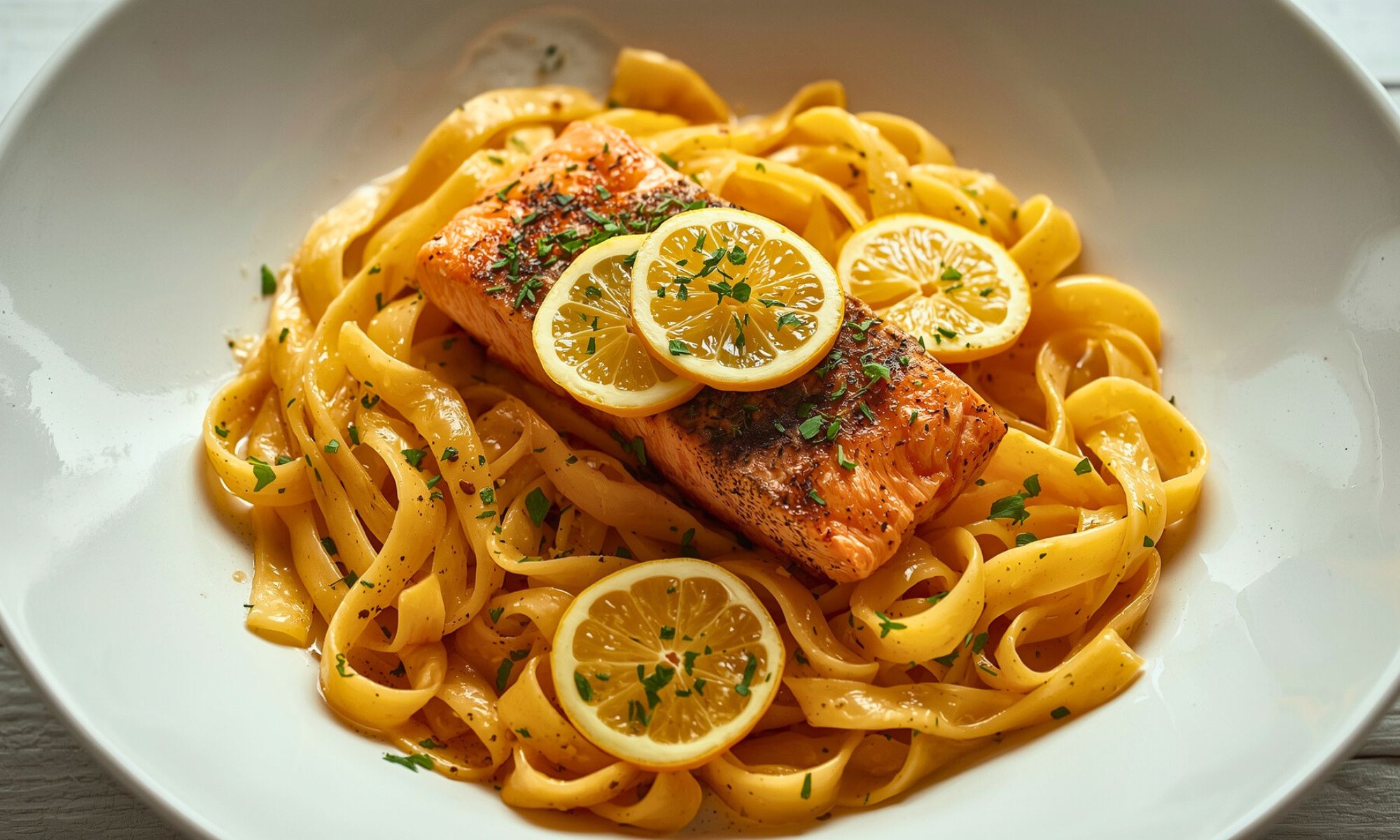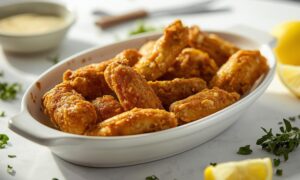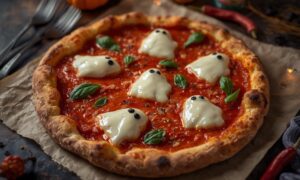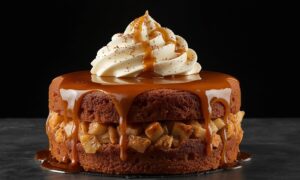You know that moment when you’re starving but the thought of greasy takeout feels more depressing than delicious? That’s exactly when Citrus Scented Pappardelle with Slow Roasted Salmon steps in, comforting enough to calm the chaos, bright enough to wake up your taste buds, and easy enough to pull off without draining what little energy the day left you.
That’s exactly how this dish happened for me. A late evening, a lemon rolling around the counter like it had been waiting for its spotlight, and a fillet of salmon that deserved better than just another quick pan fry. I dropped wide ribbons of pappardelle into boiling water, let the salmon roast low and slow until it practically melted apart, and let the kitchen fill with the scent of butter, garlic, and citrus lifting the air.
What came out was magic in a bowl: pasta that hugged every silky strand of sauce, salmon that flaked like velvet, and brightness from the citrus that made it feel indulgent without being heavy. It’s comforting, unfussy, and just refined enough to trick everyone into thinking you planned it. Stick around, I’ll walk you through the steps, share easy swaps, and give you serving tips to make Citrus Scented Pappardelle with Slow Roasted Salmon a repeat worthy weeknight win.
Why This Recipe Changes Everything
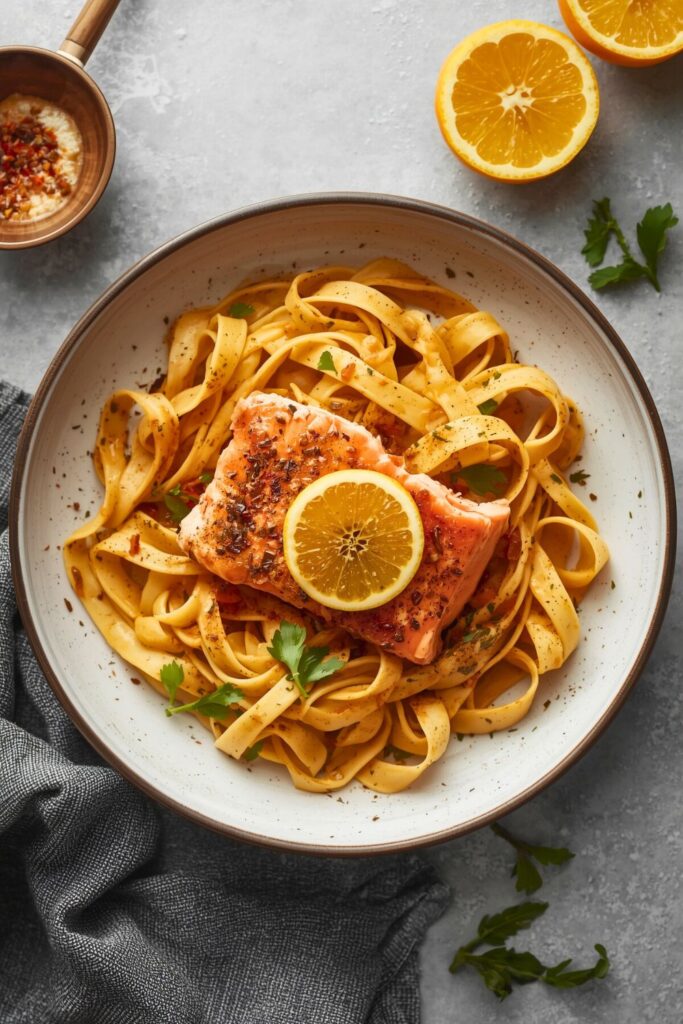
Most people think fresh pasta is intimidating. They’re wrong.
Making pappardelle from scratch takes maybe 20 minutes of active work, and the texture you get, those wide, silky ribbons that grab onto every bit of sauce, it’s worth every minute. Store bought pasta just can’t compete with that tender bite and the way homemade noodles seem to melt on your tongue.
The slow roasting technique I’m gonna share transforms salmon from a weeknight protein into something special. We’re talking low temperature, long cooking time, and a method that makes overcooking nearly impossible. Your salmon comes out with this incredible texture that’s almost like confit, rich, buttery, and so tender it falls apart with just a fork.
Here’s what really gets me excited about this recipe: the way citrus works its magic throughout the dish. We’re zesting lemon right into the pasta dough, which gives every bite this bright, aromatic quality that makes your taste buds wake up. Then we finish everything with fresh herbs and a squeeze of lemon that ties it all together.
Getting Your Ingredients Right
The Pasta Foundation
- 3 cups all purpose flour (plus extra for dusting)
- 4 large eggs (room temperature works best)
- Zest from 2 large lemons
- 1 tablespoon olive oil
- 1 teaspoon salt
- 2-3 tablespoons warm water (if needed)
The Star Salmon
- 2 pounds center cut salmon fillet, skin removed
- 3 tablespoons olive oil
- 2 cloves garlic, minced
- 2 tablespoons fresh dill, chopped
- 1 tablespoon fresh thyme leaves
- Salt and freshly cracked black pepper
- Lemon wedges for serving
Bringing It Together
- 4 tablespoons butter
- 1/4 cup pasta cooking water
- 1/4 cup fresh lemon juice
- 2 tablespoons capers, drained
- Fresh herbs for garnish
Now, let’s talk smart swaps because cooking should be flexible, not stressful.
Can’t find pappardelle at the store and don’t wanna make fresh? Fettuccine works beautifully here. The key is using something wide enough to hold onto all those lovely flavors. Even linguine will do in a pinch, though you’ll miss some of that sauce grabbing action.
No fresh herbs? Dried will work, but use about half the amount. The flavor won’t be quite as bright, but it’ll still be delicious. Fresh dill is particularly hard to substitute, so if you can find it, grab it.
Here’s a secret most people don’t know: the quality of your flour makes a huge difference in fresh pasta. I always reach for Italian “00” flour when I can find it. It creates this incredibly silky texture that’s worth the extra few bucks. But regular all purpose flour works perfectly fine, just expect slightly more texture in your finished noodles.
The Step by Step Magic of Citrus Scented Pappardelle with Slow Roasted Salmon
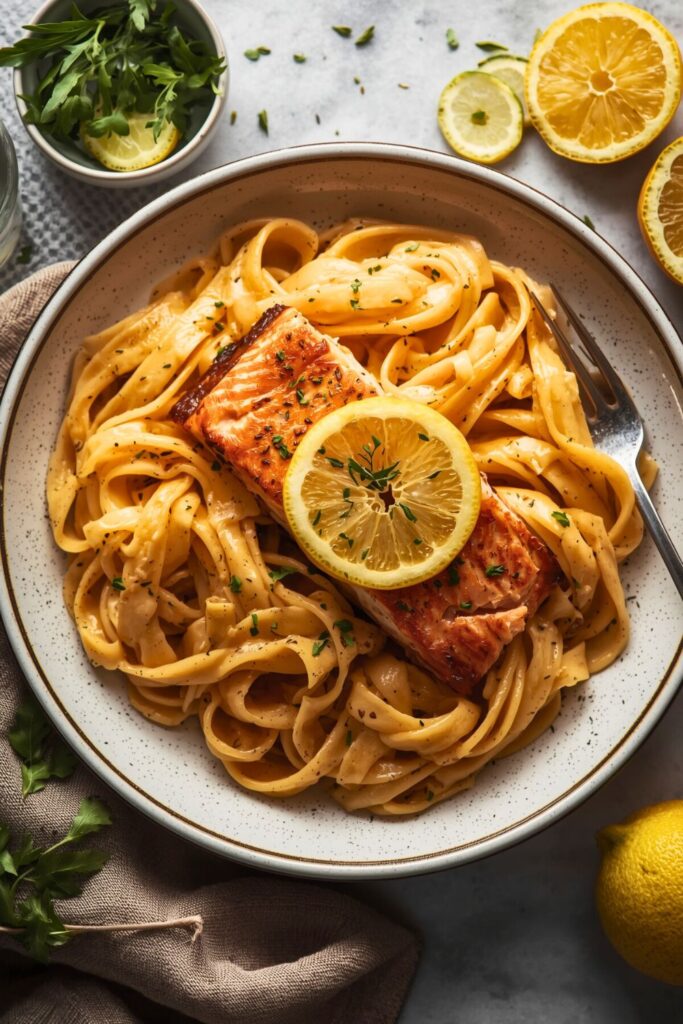
Making Your Pappardelle Shine
Start with the pasta because it needs time to rest. Create a well with your flour on a clean counter, think of it like building a volcano. Crack those eggs right into the center, add your lemon zest, oil, and salt.
Here’s where most people mess up: they try to rush the mixing process. Take your time. Use a fork to gradually incorporate the flour from the inside walls of your well. It’s gonna look messy at first, and that’s totally normal.
Once things start coming together, it’s time to knead. This is therapeutic work, so put on some music and embrace it. Knead for about 8-10 minutes until the dough becomes smooth and elastic. You’ll know it’s ready when you press it with your finger and it springs back.
Wrap that beautiful dough in plastic and let it rest for at least 30 minutes. This step isn’t optional, the gluten needs time to relax or you’ll fight with it when rolling.
Transforming Your Salmon
While your pasta rests, let’s get that salmon ready. Preheat your oven to just 275°F. I know it seems low, but trust the process.
Pat your salmon completely dry, this is crucial for getting good browning. Season generously with salt and pepper, then mix up your herb paste with olive oil, garlic, dill, and thyme.
Here’s a technique that’ll change your salmon game forever: sear it first. Heat a heavy, oven safe skillet over medium high heat. When it’s hot, add a splash of oil and lay that salmon in skin side up. Let it sear for 3-4 minutes until you get a gorgeous golden crust.
Flip it carefully, spread your herb mixture on top, then slide the whole pan into the oven. For a 2 pound piece, you’re looking at about 12-15 minutes. The internal temperature should hit 125°F for that perfect medium doneness.
Rolling Out Perfection
Back to your pasta. Divide the dough into 4 pieces and work with one at a time, keeping the others covered.
If you’ve got a pasta machine, start on the widest setting and run each piece through twice. Then gradually work your way down to about setting 6 or 7, you want these noodles to have some body to them.
No pasta machine? No problem. Roll each piece as thin as you can with a rolling pin, aiming for about 1/8 inch thick. It takes a bit more elbow grease, but the results are just as good.
To cut your pappardelle, dust the pasta sheets lightly with flour, then fold them loosely and cut into strips about 3/4 inch wide. Unfold gently and toss with a little flour to prevent sticking.
The Final Symphony
Bring a large pot of salted water to boil, and I mean really salt it. The water should taste like the sea.
Fresh pasta cooks fast, usually 2-3 minutes max. Start testing after 90 seconds because overcooked fresh pasta is heartbreaking.
While the pasta cooks, melt your butter in a large skillet over medium heat. Add the capers and let them sizzle for a minute.
Here’s the secret to silky pasta sauce: reserve some pasta cooking water before you drain. That starchy water is liquid gold for bringing everything together.
Drain your pasta and immediately toss it into the skillet with the butter and capers. Add a splash of that pasta water and the lemon juice. The sauce should coat every ribbon beautifully.
The Science Behind Your Success
The magic in this dish happens through a few key chemical reactions that transform simple ingredients into something extraordinary.
When we make fresh pasta, we’re creating a network of gluten proteins that give the noodles their structure and that perfect chewy texture. The eggs add richness and help bind everything together, while the olive oil keeps things tender.
That lemon zest isn’t just for flavor, the oils in citrus zest are incredibly aromatic compounds that release their fragrance when they hit heat. By incorporating them into the pasta dough, every bite carries that bright citrus note.
The slow roasting technique works because proteins in fish start breaking down and becoming tender at lower temperatures. When you roast salmon at 275°F, the proteins coagulate gently without becoming tough or dry. That’s why you get that incredibly silky texture that’s almost impossible to achieve with high heat cooking.
Here’s something fascinating: when we sear the salmon first, we’re creating what’s called the Maillard reaction. This browning process develops hundreds of new flavor compounds that add depth and complexity you just can’t get from gentle cooking alone.
The starchy pasta water acts as an emulsifier when we toss everything together. Those starches help bind the butter, lemon juice, and pasta into a cohesive sauce that coats every strand perfectly.
Making It Restaurant Beautiful

Presentation matters, but it doesn’t have to be complicated.
Start with warm plates, run them under hot water and dry quickly. This keeps your pasta from cooling down too fast.
Use tongs to twirl the pappardelle into loose nests in the center of each plate. Don’t overthink it, a little messiness looks more appetizing than perfection anyway.
Flake your salmon into generous chunks right over the pasta. Those herb crusted pieces should look abundant and inviting.
Finish with a sprinkle of fresh herbs, a few capers scattered around, and maybe a light drizzle of your best olive oil. A lemon wedge on the side gives people control over their final flavor balance.
For wine pairing, think crisp and bright. A good Pinot Grigio or Sauvignon Blanc plays beautifully with both the citrus and the salmon. If you prefer red, try a light Pinot Noir that won’t overpower the delicate flavors.
Simple sides work best here. Maybe some roasted asparagus or a light arugula salad with lemon vinaigrette. You want accompaniments that complement rather than compete.
Bringing It All Home
This citrus scented pappardelle with slow roasted salmon represents everything I love about cooking: simple techniques that create extraordinary results, ingredients that sing together in harmony, and a dish that makes any meal feel special.
The beauty of this recipe is how it teaches you fundamental skills while creating something absolutely delicious. Once you’ve made fresh pasta, you’ll never be intimidated by it again. The slow roasting technique will change how you cook fish forever.
Don’t be afraid to make this recipe your own. Maybe add some cherry tomatoes for color, or swap the dill for basil when summer herbs are at their peak. The technique stays the same, but the flavors can dance to whatever tune your taste buds are craving.
Here’s my final piece of advice: make extra pasta. It freezes beautifully, and having homemade pappardelle in your freezer feels like having a secret weapon for impressive dinners.
Frequently Asked Questions
Can I make the pasta ahead of time?
Absolutely! Fresh pappardelle can be made up to 24 hours ahead. Just dust it lightly with flour, form loose nests, and store covered in the fridge. You can also freeze it for up to 3 months, just cook directly from frozen, adding an extra minute to the cooking time.
What if my salmon looks done but the internal temperature isn’t there yet?
This happens sometimes with slow roasting. Just give it a few more minutes, better to be patient than to end up with dry fish. The gentle heat means you’ve got a wide window before anything goes wrong. If the top starts getting too brown, tent it lightly with foil.
My pasta sauce looks broken or oily. How do I fix it?
This usually means the emulsion broke down. Add a splash of hot pasta water and toss vigorously, the starches will help bring everything back together. If it’s still looking separated, add a tiny bit more butter and keep tossing until it comes together again.
Can I use frozen salmon for this recipe?
Sure, just make sure it’s completely thawed and patted dry. Frozen salmon tends to release more moisture, so you might need an extra minute or two of searing to get good color. The slow roasting technique actually works really well for previously frozen fish.
What’s the best way to reheat leftovers?
For the pasta, add a splash of water or broth to a skillet over medium heat, then gently warm the pappardelle, tossing constantly. The salmon reheats beautifully in a low oven, just wrap it in foil with a squeeze of lemon to keep it moist.

Swiftly Captions by Tina Smith — Quick, flavorful food recipes made simple, bringing fresh inspiration to your kitchen every day
